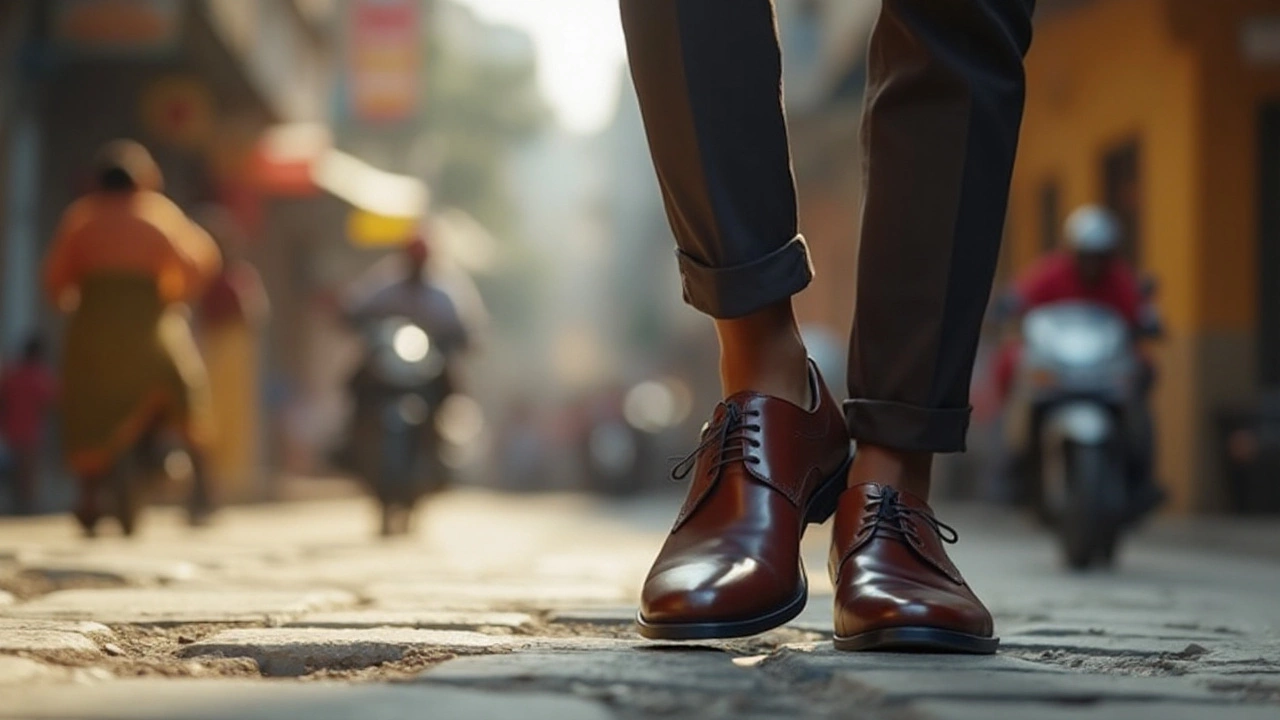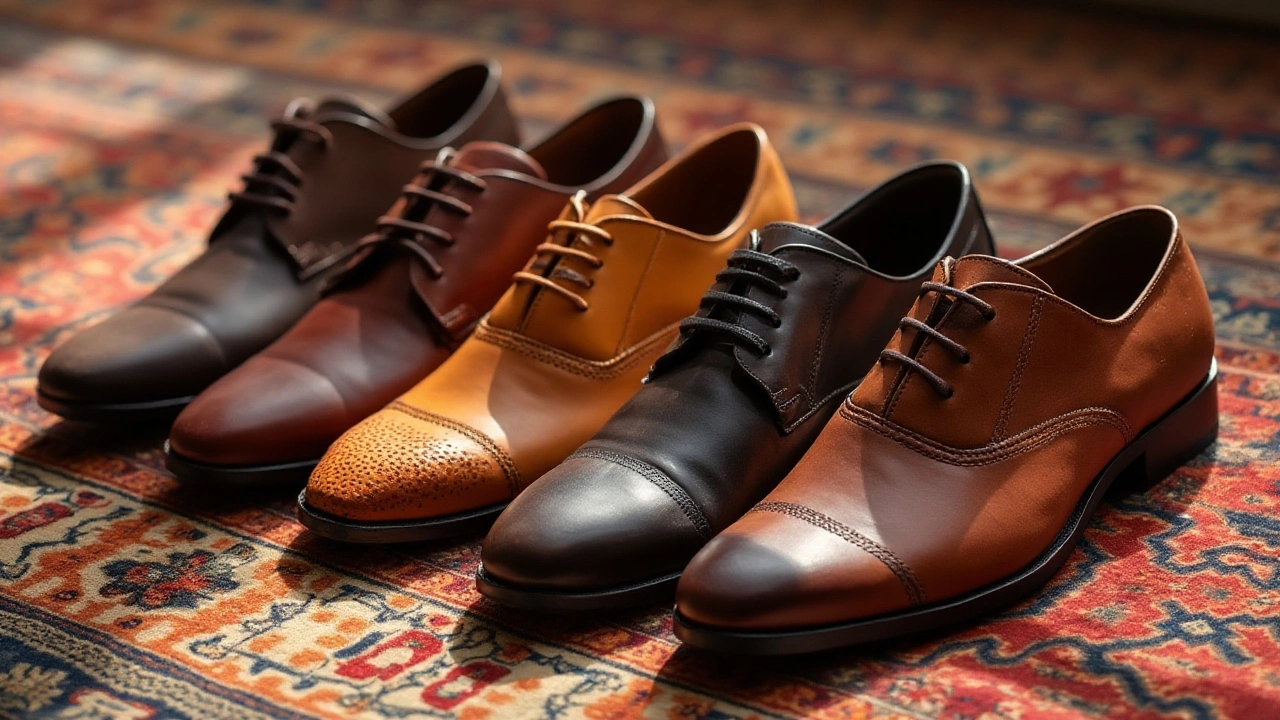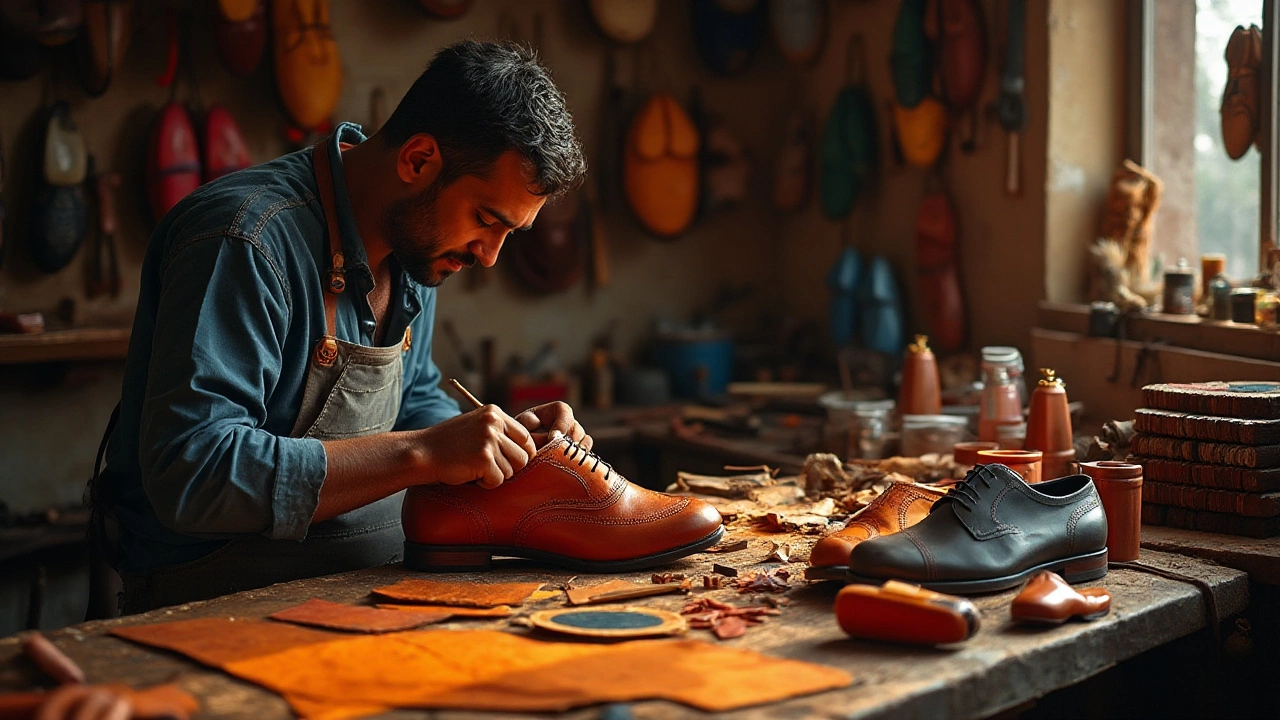Leather shoes have been adorning feet across the globe for centuries, valued for their blend of style, durability, and comfort. But do they truly offer better support and health benefits for our feet compared to other materials? As we step into an era where footwear options abound, with each claiming unique benefits, it's crucial to understand what sets leather apart.
This exploration is not just about ticking boxes of style but about assessing how leather interacts with our skin and supports the structure of our feet. From its ability to breathe through intricate weaves to its endurance over years of use, leather promises much. But promises aside, do these qualities translate into tangible foot health benefits?
We'll also touch upon the modern dilemmas of choosing between traditional leather and innovative synthetic options, offering tips on making the right choice for your lifestyle. Whether you're a seasoned leather enthusiast or considering your first investment, understanding the nuances of leather shoes can lead to healthier, happier feet.
- Understanding Leather: A Historical Perspective
- Breathability and Comfort
- Durability and Longevity
- Leather Shoes vs. Alternatives
- Choosing the Right Leather Shoes for You
Understanding Leather: A Historical Perspective
Tracing back through the annals of human history, the use of leather is as ancient as civilization itself. Its story begins over 7,000 years ago, with the discovery of preserved hide garments adorning the bodies of our Stone Age ancestors. These early peoples discovered that animal skins, when treated, became a durable material that provided both protection and comfort, making it an indispensable resource for prehistoric societies. The evolution of leather craftsmanship can be witnessed in this long lineage, reflecting human ingenuity and adaptation over millennia.
As we journey through time, leather's role only magnified. In ancient Egypt, leather was not just practical but luxurious, utilized in everything from furniture to clothing by those of high rank. By the time of the Romans, leather had become essential for military gear. The legions marched to their conquests in sandals and shields reinforced with leather for flexibility and durability. This unique combination of toughness and malleability boosted leather's status across cultures and contexts.
The Middle Ages saw leather take center stage in European trade, with its value recognized by traders and craftsmen alike. It was during this period that tanning techniques advanced significantly, leading to a diversity of finishes and colors. This era was the precursor to what would become modern leather production, focusing on enhancing the natural qualities of the material to better serve various societal needs. The documentations from the time are filled with references to thriving leather workshops and bustling markets, cementing leather as a staple commodity.
The rise of the industrial age in the 18th century marked a pivotal leap forward. "With the advent of mechanization, leather production transformed," notes Dr. Jane Thompson, a historian specializing in material culture. "It became both an art and a science, leading to innovations that could meet the burgeoning demand of a rapidly growing population." Factories replaced handcraft, and the invention of the splitting machine allowed for thinner leathers, diversifying its applications further.
Fast-forward to the contemporary era, leather remains as relevant as ever, though the narrative has shifted slightly. Today's discussions often center around sustainability and ethical sourcing, as modern consumers become more conscious of their impact on the planet. Yet, leather maintains its allure due largely to its unparalleled qualities—breathability, durability, and aesthetic appeal—all of which are pivotal for anyone considering the best footwear benefits for their everyday needs. This enduring material, forged through countless innovations and transformations, continues to hold a timeless place in our wardrobes and beyond.
Interestingly, the modern leather industry has taken great strides in addressing environmental concerns. The introduction of vegetable tanning and other eco-friendly processes illustrates a commitment to responsible production. Leather's legacy is not only rooted in its ancient past but also in its ability to continuously evolve to meet the demands of each new era, ensuring its place both in history and in our future.
Breathability and Comfort
Leather shoes have long been applauded for their unique ability to combine sturdiness with breathability, making them a staple for those seeking comfort. Natural leather, unlike many synthetic materials, has the innate capability to allow air to circulate, reducing moisture accumulation inside the shoe. This property not only keeps feet cool but also helps prevent the growth of bacteria and fungi, which thrive in damp environments. Thus, when you're wearing leather, your feet don't just feel more comfortable, they are actually healthier in many ways too. Notably, this breathability is due to leather’s fibrous structure that permits air flow, setting it apart from less porous synthetic options.
The comfort of leather shoes goes beyond just breathability. Leather is known for its ability to adapt to the shape of the wearer's feet over time, leading to a personalised fit that cushioning materials often can't replicate. This adaptive quality can significantly alleviate pressure points and can reduce foot fatigue during long periods of standing or walking. According to a study from the Leather Research Institute, the softness and adaptation of leather shoes significantly contribute to prolonged comfort in various environmental conditions.
"Leather is an optimal material for shoe production, marrying durability and comfort in perfect balance," states Dr. John Parker, a leading podiatrist with over twenty years of experience in foot health.
Besides breathability and comfort, another crucial factor often highlighted by enthusiasts is leather’s durability. But what many might not realize is how this plays into long-term comfort. Shoes that maintain their shape and integrity over extended wear can provide consistent support without the sagging or degradation seen in less robust materials. This ensures that each step is cushioned and supported just as well on day one hundred as it was on day one. Importantly, the natural properties of leather aid in resisting weather variations too, meaning your feet stay comfortably shielded from outside conditions whether it’s rain or shine, hot or cold.
Moreover, leather's breathability paired with its odor-resistant nature makes it a favored choice for everyday wear. For those who spend long hours in their shoes, these qualities do not go unnoticed. A 2022 survey by the Global Footwear Association indicated that 70% of respondents preferred leather shoes due to their enduring comfort, with many citing breathability as a primary reason for their preference. Foot health, supported by proper breathability and comfort, requires investing in materials that respect the anatomical needs of the foot, and leather fits this bill spectacularly.

Durability and Longevity
When it comes to footwear, nothing quite matches the long-standing reputation of leather shoes for durability and longevity. This enduring quality is largely owed to the innate toughness of leather, which has been used for centuries in various forms of clothing and accessories due to its strength and resilience. Leather is a material that ages gracefully, often growing more attractive with use as it develops a unique patina that only adds to its charm. This is contrary to many synthetic materials, which tend to degrade and lose their appeal over time. Leather’s ability to withstand wear and tear makes it the ideal material for shoes that are expected to endure frequent use.
Moreover, the durability of leather shoes comes not just from the material itself but also from the craftsmanship that often accompanies their production. Traditionally, leather shoes are handcrafted, which means each piece is carefully measured and expertly sewn, ensuring a perfect fit. This attention to detail contributes significantly to their longevity. Properly cared for, a well-made pair of leather shoes can last several years, far outlasting many mass-produced alternatives. This makes them an investment not only in style but also in practical, long-term value.
To truly harness the longevity of leather shoes, maintenance plays a critical role. Regular cleaning and conditioning help maintain the flexibility and appearance of the leather, preventing drying and cracking. Shoe maintenance can be thought of as a ritual, where polishing provides a sense of pride and ownership. Some enthusiasts even argue that nurturing leather shoes builds a deeper connection to the footwear, enhancing the appreciation of their durability. As a shoe lover, the act of caring can be as rewarding as wearing them.
"Leather is one of nature’s great gifts," says John Henry, a renowned shoemaker from Northampton, England. "It's tough, it breathes, and if you take care of it, leather shoes repay you with years of service."
If we dissect the elements contributing to the durability of leather shoes, it's clear that both the quality of the leather and the construction techniques are critical. Full-grain leather is generally considered the highest quality due to its intact, dense fibers. When combined with techniques like Goodyear welt construction, which involves stitching the layers together in a way that allows for easy repairs, the result is an article of footwear that stands the test of time. It's not uncommon to find individuals resoling their cherished leather shoes multiple times, extending their life indefinitely.
To illustrate the value of this longevity, a simple comparison can be seen in the cost-effectiveness of leather shoes over time. Though the initial purchase might seem steep, the extended lifespan and ability to endure harsh conditions make leather shoes a more economical choice in the long run. This contrasts sharply with cheaper, synthetic shoes that often need replacement within a year due to structural failures or aesthetic depreciation. For someone looking to invest in footwear that not only looks great but also serves them efficiently over the years, leather shoes present a compelling option.
In conclusion, the choice of leather shoes extends beyond mere aesthetics. It's about a partnership with your footwear that rewards conscientious care and maintains its relevance as styles evolve. Their durability and longevity stem from natural resilience, craftsmanship, and proper care, making them not just a purchase, but a deeply satisfying experience for the wearer.
Leather Shoes vs. Alternatives
In the world of footwear, a debate has long simmered between the advocates of leather shoes and those who prefer modern synthetic materials. Walking through any shoe store, you're faced with an array of options, each promising its unique set of benefits. But what truly sets leather apart from its synthetic counterparts? One significant advantage of leather is its natural breathability. Unlike many synthetic materials, leather allows air to circulate around your feet, which can help reduce sweating and odors, keeping your feet feeling fresh over prolonged periods of wear. This natural quality is highly prized, especially in environments where you need to wear shoes for extended durations.
Synthetic materials often boast about being lightweight, water-resistant, or even more cost-effective, yet they routinely fall short when it comes to durability and shaping over time. Leather, known for its impressive longevity, can outlast these alternatives by years if maintained properly. It molds to the unique shape of your foot, offering personalized comfort that synthetic counterparts often struggle to replicate. In many ways, it's this adaptability over time that wins loyalists to its fold. The weight of the shoe also plays a crucial role. A study revealed that people overwhelmingly preferred the feel and balance of leather shoes in varied terrains due to their sturdy build.
"Leather remains one of the few materials that age gracefully, not just enduring the test of time but telling a story through every crease," notes footwear historian Johnathan Fields.When you consider aesthetics, leather shoes often come with an unparalleled timelessness. Whether attending a formal event or a casual outing, leather shoes offer versatility and an inherent elegance that synthetic varieties often cannot match. Quality leather develops a patina with age, enhancing its beauty rather than degrading its appeal. Still, synthetic shoes hold a strong position in the market, primarily due to their cost-efficiency. For those on a budget or looking for specialized features like extreme waterproofing, synthetics offer a compelling option. Many athletic shoes, for example, utilize cutting-edge materials to enhance performance, weight reduction, and specific functionalities that leather simply can't provide.
However, while the initial price tags of leather shoes can be daunting, they often prove more economical in the long run due to fewer replacement needs. A fascinating contrast highlighted in a 2022 consumer survey found that although synthetic shoes rose to over 65% of sales volume in budget ranges, leather shoes accounted for more than 75% in premium categories. This tells a story of where value prevails over sheer number in terms of long-term consumer satisfaction.
| Feature | Leather Shoes | Synthetic Shoes |
|---|---|---|
| Durability | High | Moderate |
| Breathability | Excellent | Poor to Moderate |
| Cost | Initial high, cost-effective over time | Low initial, less longevity |
| Aesthetics | Timeless | Varies |

Choosing the Right Leather Shoes for You
When it comes to selecting leather shoes, there is more to it than simply picking the first pair that catches your eye. Understanding the nuances of what makes a great leather shoe involves considering several factors that ensure both comfort and durability. Firstly, the type of leather is paramount. Full-grain leather, being the highest quality, maintains the natural grain of the hide and is incredibly durable. Shoes made from this leather tend to age well, developing a unique patina—a testament to its quality and endurance. In contrast, corrected-grain leather undergoes sanding to remove imperfections, making it less durable in comparison.
Another essential consideration is the shoe's construction. Goodyear welted shoes, for example, are renowned for their impeccable construction method where an additional layer of leather is stitched around the edge of the shoe, enhancing its longevity. Such construction not only makes the shoes water-resistant but also makes it easier to replace the sole, extending the life of the footwear significantly. Always check the insoles, as removable ones can be replaced for better hygiene and comfort.
Fit and comfort should never be compromised. Leather shoes might initially feel snug, but quality leather tends to stretch and mold to the shape of your foot, offering a custom fit over time. However, ensure there is enough room in the toe box to avoid constriction, which could lead to discomfort or foot issues over prolonged use. When in doubt, it's often wise to try the shoes on in the afternoon when feet tend to be at their largest due to natural swelling.
According to The New York Times, "Investing in well-made shoes can be financially sound since repairing and resoling them often costs less than replacing cheaply made alternatives."
Don't underestimate the importance of shoe care. Proper maintenance not only preserves appearance but also enhances the leather's natural properties. Regular conditioning and polishing help maintain the leather's suppleness and color. Keep your shoes away from direct heat sources and allow them to dry naturally if they become wet. This prevents the leather from cracking and preserves the shoe's integrity.
Lastly, consider the purpose and occasion for which you are buying the shoes. For formal settings, you might opt for classic designs like Oxfords or Brogues which offer an air of sophistication. For casual wear, loafers or leather sneakers provide comfort without sacrificing style. Color also plays a role—black is versatile and formal, whereas brown offers a more relaxed feel and matches well with various outfits. Footwear benefits ensure you not only look good but feel good, stepping confidently into any situation life throws your way.
For further insight, take note of fit guides provided by manufacturers or retailers. Some brands offer specific sizing solutions tailored to help you find the perfect pair. If the shoe fits perfectly, quite literally, it's likely to contribute significantly to your foot health, providing not just protection but ease and style as you walk the miles of life.
